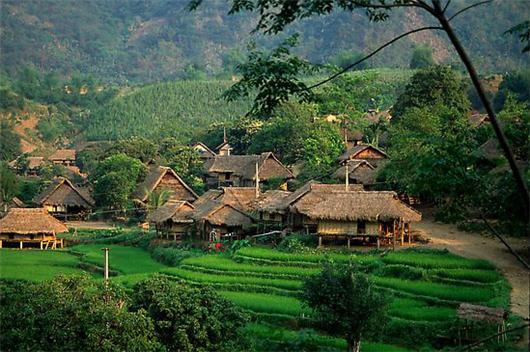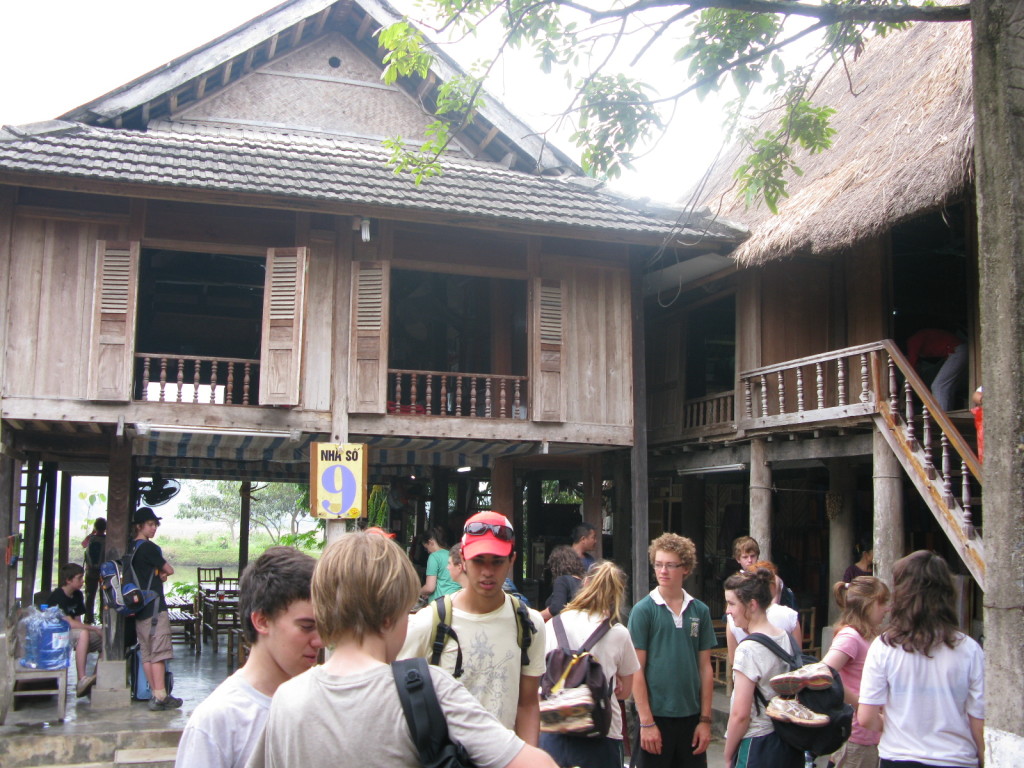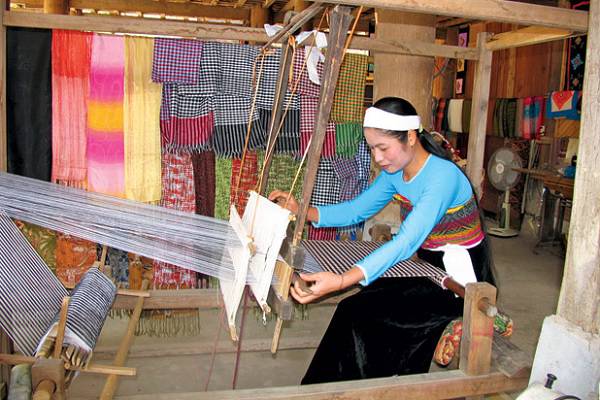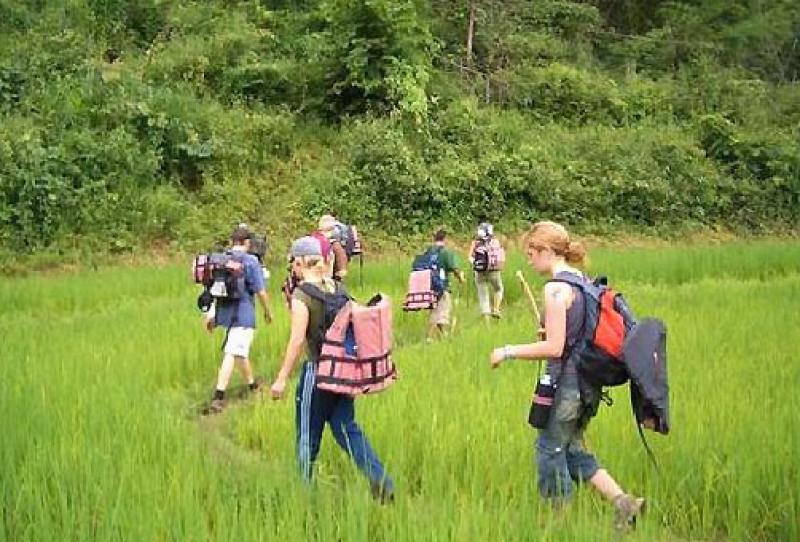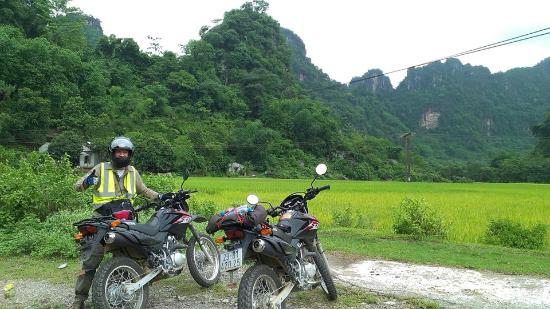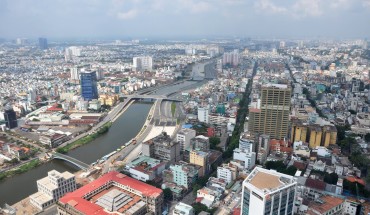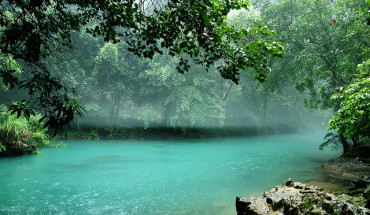Mai Chau makes a good overnight after the shakedown cruise from Hanoi (about a 5-hr. ride). The town center is a rather dull strip of small shops and a few pho and com stands (noodle soup or rice), but there are two White Thai villages just outside of town where 143 both solo travelers and group tours commonly stay. You can take short boat trips on the Da River Reservoir from the pier just near the turnoff road to Mai Chau (best arranged through a tour).
Where to Stay
In addition to the recommendation below, the other option In town is to stay at one of the nearby White Thai villages of Ban Lac of Pom Coong. If you travel through this way on tour, you will most likely be spending the night at Mai Chau local homestay, sleeping under a thatch roof on bamboo woven floors. Tourists have been staying here a while, and some folks even hang signs to invite visitors in. Most home stays have electric lights and TVs. You’ll pay a flat fee and dine with a family. Just walk or ride to the villages sometime well before sunset. Just before you arrive at the Mai Chau Guesthouse, which is at the farthest end of Mai Chau town, you’ll see a little booth where they charge a few thousand dongs to enter this hill tribe area, but no one has been manning it lately. Just before the guesthouse and right in front of the booth, there is a small path through the rice fields to Ban Lac, and the path to Pom Coong is past the guesthouse a few hundred meters and to the right. The people of these villages are White Thai, and most of the women still wear traditional dress. A stay or a brief visit is a good glimpse into While Thai culture, and a rustic overnight in the village is certainly more interesting than the plain-Jane Mai Chau Guesthouse.
Mai Chau Guesthouse This plain building with dull rooms is the only tourist hotel of any sort for miles. The staff is friendly and can direct you to hikes in the villages, but it’s a pretty basic affair. And the nearby karaoke bars, most on floats or suspended on a nearby pond, are a major drawback to staying here. If you check into the guesthouse in the early evening, you can enjoy a calm sunset, but not long after, the crooners arrive; get ready for some noisy racket until about 10pm.
At the farthest end of town, Mai Chau, Hoa Binh. No credit cards. In room: No phone.
Where to Dine
Dinner in Mai Chau (or “Your Chow, ” as my puny travel companion pointed out) is offered at just a few small local storefront restaurants. Ask at the front desk of the Mai Chau Guesthouse for a recommendation, and be armed with a few phrases on food like com trung (fried egg with rice), rau xau (mixed vegetables), or pho bo (noodle soup with beef). For more language help, see chapter 16. A few Internet outposts are in the town, but service is very slow.
Attractions
The surrounding villages of Ban Lac and Pom Coong are great for a morning wander, whether you spent the night in a village homestay or at the Mai Chau Guesthouse. The villages are touristed-out, meaning that the little dusty streets are now paved, and that though the hospitality is genuine, the folks here lead with handfuls of souvenir items for sale and not a handshake. The surrounding valley is green with rice fields and laced with fun little tracks. Bring a camera and your sense of adventure, and get lost out on the paddies for a few hours before heading on to Son La. Local guides can be hired from the Mai Chau Guesthouse for trekking farther afield.
The Minsk: A Guide to Renting & Enjoying Your Big Honkin’Soviet Motorbike
So you want to really get out and see the far north on your own? Well, one way to do it is to get yourself a Minsk. Built in Minsk, Belarus, by the Motovelo corporation, these sturdy 100cc machines come in two different models: 1) the older classic Minsk, which is a model of Soviet-style “function, not form” design principles; and 2) the sport Minsk, a higher-profile bike with better suspension, something like a standard motocross bike, but with the same engine as the classic Minsk.
A Minsk is still your best bet for reliability, durability, and easy fixability, as just about everyone up this way has one and can help you with even major repairs. Hairpins and bailing wire often suffice as replacement parts, and even the smallest little country repair shop is staffed with someone who can tap apart the crank case and fix major problems. Locals appreciate your adventurous spirit (or call you crazy) for striking out on these old hunks of metal to explore their country. Once a security guard at a hotel gave my bike a full tune- up just for the love of the bike and to ensure I’d have a safe trip. And these bikes will make a mechanic out of you: The principles of the internal-combustion engine couldn’t be clearer than if Fred Flintstone himself designed it.
Be sure to learn the phrase Xang Fa Dao (sounds like “Sang Fa Zow”), which means “gas with oil, ” and Nam Fa Jam, which means “5%.”Minsks are two-stroke, or two-cycle, motors (something like your lawn mower, weed whacker, or go- kart back home), and you need to mix 5% oil with the gas. In the countryside, folks at gas stations are very adept at this because they’re used to dealing with Minsks and other two-stroke machines, but be careful in cities, where gas station attendants know only scooters. When filling up with gas, be sure to turn off the fuel line connecting to the engine, and help the attendant, who will either measure a cup of oil and then thin it out by adding gas directly to the cup, suspended over a funnel into your tank, or mix the oil and gas in a separate can. In either case, watch closely and see that the bike gets oil. When you start off, keep the fuel line closed and make some slow, swerving turns to mix the gas; then open the fuel line to the normal setting.
There are two good rental agencies in Hanoi:
• Mr. Cuong’s Motorbike Adventure (1 Luong Ngoc Quyen St., on the east side of the Old Quarter near the city’s major ring road; 04/3926-1534) is the best place for straight-up rental. Cuong is a mechanic and keeps a large stable of Minsks in good condition. Each bike is nearly rebuilt after every rental. You’ll pay the standard $7 per day, which includes a good helmet, but that’s where service stops. Mr. Cuong’s place is open daily from 8am to 6pm, and he’s a very understanding man, cutting you little breaks like charging for a half-day if you bring it back early and lending extras at no cost to you.
• Mr. Hung’s Vietnam Adventure Tour, on the other hand, provides motorbike rentals as well as comprehensive guide services. For just $30 per day, you can hire a bike and an accompanying guide with his own bike. Choose from a number of well-planned routes around the north, enjoying ease of navigation and easier connection to locals. If you’re considering going it alone, some folks have reported that Hung’s bikes aren’t quite as well maintained as those at Cuong’s (see above), but if you’re looking for more of a tour, Mr. Hung’s is the place to start. Find him at his small storefront travel agent just north of Hoan Kiem Lake at 5A Dinh Liet St. ( 04/3926- 0938), and someone there can take you to his repair shop on the city ring road at 162 Tran Quang Khai St. (just around the corner from Mr. Cuong’s). When renting a Minsk, you’ll have to leave your yellow paper, a rather valuable little Customs certificate that you’ll need (or face a fine and some bureaucratic hassles) when leaving the country. Most shops ask that you pay in advance and sign a contract that gives you complete responsibility for the bike’s well-being. Demand a lock and use it when leaving the bike for long intervals (most Minsks do not have key ignitions and therefore are easily started by anyone).
Safety Demand a helmet and wear it; go slow; and honk to alert other vehicles when passing. Stay alert! Vietnamese roads are chaotic, and something or somebody is always leaping out onto the roadway or veering into your lane. The hardest part about any trip in the north is navigating Hanoi’s crazy traffic and finding your way out of the city; in fact, both Mr. Hung and Mr. Cuong are given to leading their more inexperienced clients out of the city center to more sane open roads.
What to Bring In the little metal storage cases on the side of the bike (for older models) or under the seat, pack an extra tube, a patch kit, a few spark plugs, a spark-plug wrench, and a crescent wrench; most rental shops will provide it all, but be sure to ask. Minsks leak oil in fact, just getting close to the bike usually means you get a few smudges on you—so bring two sets of clothes: one grungy pair of long pants, T-shirt, and light jacket that you won’t mind getting covered in oil and road splatter during the day, as well as a clean set of dry clothes, including something warm like a sweatshirt or fleece for those chilly highland nights. Minsks can be outfitted with handy saddlebags, or else you can bungee your gear onto the rack at the back of the bike. Then keep a light day pack of daily-use items (camera, journal, wallet, and so on) on your back or at the top of the saddlebags. A “dry bag” is good to have at the ready should you hit some rain and want to just tuck away readily used items and valuables (I also drop my money belt into the dry bag if the rain starts). Be sure to bring bug repellent, a flashlight, and a hat for day hikes and cave exploring. Wear long pants, preferably jeans, when riding, and wear boots, if possible, and at least shoes or sneakers, if not (no sandals), but bring something light like flip-flops for the evening.


